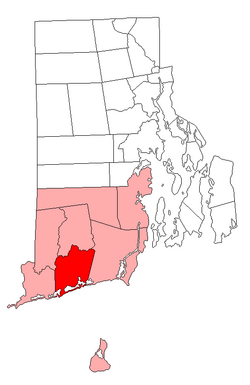Charlestown, Rhode Island
| Charlestown, Rhode Island | |
|---|---|
| Town | |
 Location of Charlestown in Washington County, Rhode Island |
|
| Coordinates: 41°23′7″N 71°40′5″W / 41.38528°N 71.66806°WCoordinates: 41°23′7″N 71°40′5″W / 41.38528°N 71.66806°W | |
| Country | United States |
| State | Rhode Island |
| County | Washington |
| Government | |
| • Town Council | Thomas B. Gentz George C. Tremblay Virginia Lee Denise L. Rhodes Bonnita B. Van Slyke |
| • Town Moderator | Dana Jeffers |
| Area | |
| • Total | 59.3 sq mi (153.6 km2) |
| • Land | 36.8 sq mi (95.4 km2) |
| • Water | 22.5 sq mi (58.1 km2) |
| Elevation | 59 ft (18 m) |
| Population (2010) | |
| • Total | 7,827 |
| • Density | 212.7/sq mi (82.0/km2) |
| Time zone | Eastern (EST) (UTC-5) |
| • Summer (DST) | EDT (UTC-4) |
| ZIP code | 02813 |
| Area code(s) | 401 |
| FIPS code | 44-14500 |
| GNIS feature ID | 1220080 |

|
|
Charlestown is a town in Washington County, Rhode Island, United States. The population was 7,827 at the 2010 census.
Charlestown is named after King Charles II, and was incorporated in 1738. The area was formerly part of the town of Westerly. It was in turn divided and the part north of the Pawcatuck River became the town of Richmond in 1747.
According to the United States Census Bureau, the town has a total area of 59.3 square miles (154 km2), of which, 36.8 square miles (95 km2) of it is land and 22.5 square miles (58 km2) of it (37.86%) is water.
The town is bordered by Westerly on the west; Richmond on the north; and Hopkinton on the northwest; and South Kingstown on the east.
In 2011, Charlestown became the first municipality in the United States to pass a ban on any size or type of electricity-generating wind turbines. The sweeping prohibition applies to large commercial as well as smaller residential turbines. This temporary measure was in order to draft a new ordinance providing for small turbines but prohibiting commercial turbines.Residential Wind Energy Facilities. [Amended 3-14-2011 by Ord. No. 338; 9-12-2011 by Ord. No. 341; 11-14-2011 by Ord. No. 344] Purpose. The purpose of this section is to provide for the construction and operation of wind energy facilities as accessory uses and structures for residential and agricultural uses, and to provide standards that address public health, safety and welfare in the placement, design, construction, monitoring, modification and removal of wind energy facilities and minimize negative impacts on scenic, natural and historic resources of the town. (b)
...
Wikipedia

